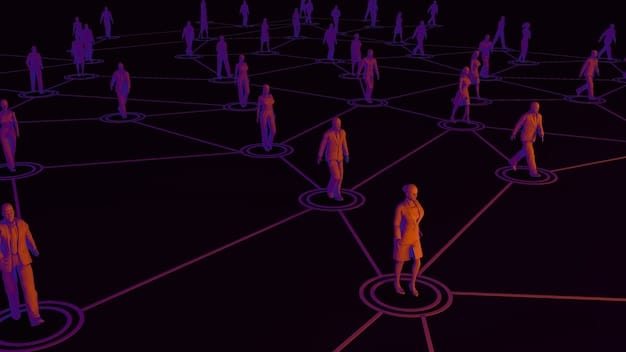Ethical AI Surveillance Tech: Navigating US Implications

The ethical implications of AI-driven surveillance technology in the US encompass concerns about privacy violations, algorithmic bias, lack of transparency, and potential for misuse, impacting civil liberties and social justice.
The rise of AI-driven surveillance technology in the United States presents unprecedented opportunities for monitoring and security, but it also raises profound questions about our fundamental rights. Let’s delve into what are the ethical implications of AI-driven surveillance technology in the US and explore potential pathways toward responsible implementation.
Understanding AI-Driven Surveillance Technology
AI-driven surveillance technologies are rapidly transforming how data is collected, analyzed, and used in the United States. These technologies, ranging from facial recognition systems to predictive policing algorithms, offer both enhanced capabilities and significant ethical challenges. Understanding the scope and functionality of these tools is crucial before delving into their ethical implications.
Types of AI Surveillance Technologies
AI surveillance encompasses a variety of tools each designed to automate and enhance traditional surveillance methods. These technologies use artificial intelligence to process massive amounts of data, identifying patterns and anomalies that would be impossible for humans to detect manually.
- Facial Recognition: Identifies individuals by analyzing facial features, often used at airports, public events, and in law enforcement.
- Predictive Policing: Algorithms analyze historical crime data to predict future crime hotspots, influencing resource allocation and patrol strategies.
- Behavioral Analysis: AI monitors individuals’ behaviors to detect suspicious or anomalous activities, often used in cybersecurity and physical security settings.
- Voice Recognition: Identifies individuals or analyzes conversations through voice patterns, used in surveillance and authentication systems.
These technologies represent a significant shift in surveillance capabilities, promising enhanced security but also posing serious ethical questions.

How AI Enhances Surveillance Capabilities
AI’s capabilities extend far beyond traditional surveillance methods, offering unparalleled speed, accuracy, and scalability. This enhancement is primarily due to AI’s ability to process and learn from vast datasets, enabling it to identify patterns and anomalies in real-time.
- Automation: AI automates many tasks previously performed by human analysts, reducing manpower needs and increasing efficiency.
- Data Processing: AI can process enormous datasets from multiple sources to identify trends and patterns that would be impossible for humans to detect.
- Real-Time Analysis: AI allows for real-time monitoring and analysis, enabling immediate responses to identified threats.
- Predictive Capabilities: AI algorithms can predict future events based on historical data, allowing for proactive intervention.
The integration of AI into surveillance creates opportunities for enhanced security, but also increases concerns about privacy and potential misuse.
In conclusion, AI-driven surveillance technologies substantially augment traditional methods by providing automation, rapid data processing, and predictive capabilities. However, this enhanced ability also brings considerable ethical considerations that must be carefully considered to safeguard civil liberties.
Ethical Dilemmas in AI Surveillance
The deployment of AI-driven surveillance in the US brings forth several intricate ethical dilemmas. These challenges span from privacy concerns and biases to the impact on civil liberties and the potential for misuse. Ensuring responsible implementation requires careful consideration and robust ethical frameworks.
Privacy Violations and Data Security
One of the primary ethical concerns revolves around privacy violations. AI’s capacity to collect, analyze, and store vast amounts of personal data raises questions about the boundaries of surveillance and the protection of individual rights.
- Mass Data Collection: AI-driven systems often collect data indiscriminately, capturing information from individuals who are not suspected of any wrongdoing.
- Data Storage and Retention: The storage of sensitive data over extended periods increases the risk of data breaches and misuse.
- Lack of Transparency: Individuals are often unaware of when and how their data is being collected and used.
- Third-Party Access: Sharing data with third parties raises concerns about data security and potential misuse of personal information.
These privacy violations can lead to a chilling effect on freedom of expression and assembly as individuals become wary of being monitored.
Addressing these concerns requires implementing strong data protection measures, increasing transparency, and establishing clear guidelines for data collection and retention.
Algorithmic Bias and Discrimination
AI algorithms are trained on data, and if that data reflects existing biases, the algorithms can perpetuate and amplify these biases. This can lead to discriminatory outcomes, particularly in areas like law enforcement and public services.
- Bias in Training Data: If the data used to train AI algorithms reflects historical biases (e.g., racial profiling in crime data), the AI system will likely perpetuate these biases.
- Disproportionate Impact: Biased algorithms can disproportionately affect minority groups, leading to unfair or discriminatory outcomes.
- Lack of Accountability: It can be difficult to identify and correct biases in AI systems, leading to a lack of accountability for discriminatory outcomes.
- Data Quality Issues: Inconsistent and inaccurate data can exacerbate biases, leading to unreliable and unfair results.
Mitigating algorithmic bias requires careful data curation, fairness-aware algorithm design, and ongoing monitoring and evaluation of AI systems.
Algorithmic bias not only results in discriminatory outcomes but also undermines trust in AI technology and institutions that deploy it.
In summary, the ethical dilemmas of AI surveillance, particularly privacy violations and algorithmic bias, demand immediate and concerted attention. Implementing strong regulatory frameworks and ethical guidelines is crucial to mitigate these issues and ensure technology supports fairness and justice.
Impact on Civil Liberties and Social Justice
The increasing use of AI-driven surveillance technologies in the US can significantly impact civil liberties and social justice. Over-surveillance, the erosion of privacy, and the potential for discriminatory practices pose serious threats to societal values. It is essential to critically examine these impacts to safeguard fundamental rights.
Erosion of Privacy and Freedom of Expression
AI surveillance has the potential to erode privacy and stifle freedom of expression by creating a climate of constant monitoring and fear of reprisal. This can have profound effects on democratic participation and civic engagement.
- Chilling Effect: Knowing that one’s actions and communications are being monitored can deter individuals from expressing dissenting opinions or participating in lawful protests.
- Loss of Anonymity: The ability to track and identify individuals in public spaces undermines anonymity, which is essential for free speech and assembly.
- Dataveillance: Continuous monitoring of online and offline behavior enables the creation of detailed profiles, which can be used to manipulate or control individuals.
Protecting privacy and freedom of expression requires limiting the scope of AI surveillance, increasing transparency, and establishing robust oversight mechanisms.
Disproportionate Surveillance of Marginalized Communities
AI surveillance often disproportionately targets marginalized communities, reinforcing existing power imbalances and exacerbating social inequalities. This can lead to over-policing, discrimination, and the denial of equal opportunities.

- Targeted Surveillance: AI systems are often deployed in areas with high concentrations of minority groups, leading to increased surveillance in these communities.
- Algorithmic Discrimination: Biased algorithms can result in discriminatory outcomes, such as wrongful arrests or denial of services.
- Lack of Representation: Marginalized communities are often excluded from the design and oversight of AI systems, resulting in policies that do not reflect their needs and concerns.
Achieving social justice requires addressing the root causes of inequality and ensuring that AI surveillance is used fairly and equitably.
Implementing community-based oversight mechanisms and diversifying the tech industry can help ensure AI systems reflect the values and priorities of all communities.
Potential for Misuse and Abuse of Power
The concentration of surveillance power in the hands of government agencies and private companies raises concerns about the potential for misuse and abuse of power. Without adequate safeguards, AI surveillance can be used to suppress dissent, manipulate public opinion, and violate human rights.
The risks associated with concentration of power necessitate establishing independent oversight bodies, enacting strong whistleblower protections, and promoting transparency and accountability in the deployment of AI surveillance.
The impact of AI-driven surveillance on civil liberties and social justice highlights need for comprehensive regulatory reforms and ethical guidelines. These measures must prioritize protection of privacy, fair treatment, and equitable outcomes to prevent erosion of basic rights.
Legal and Regulatory Frameworks in the US
The legal and regulatory frameworks governing AI-driven surveillance in the US are currently fragmented and lack comprehensive oversight. The absence of clear and consistent standards poses challenges for safeguarding civil liberties and ensuring accountability. Establishing robust frameworks is critical for guiding the ethical deployment of these technologies.
Current Laws and Loopholes
Existing US laws were not designed to address the unique challenges posed by AI surveillance, leading to legal loopholes and gaps in protection. These gaps allow for unchecked surveillance practices that can violate individual rights.
- Lack of Specific AI Laws: There are no specific federal laws that directly regulate the use of AI in surveillance, creating ambiguity and uncertainty.
- Fourth Amendment Interpretation: The Fourth Amendment’s protection against unreasonable searches and seizures is often narrowly interpreted, failing to adequately address new surveillance technologies.
- Data Privacy Laws: Current data privacy laws vary widely by state and do not provide comprehensive protection against the collection, use, and sharing of personal data.
Proposed Legislation and Policy Recommendations
Several legislative proposals and policy recommendations aim to address the gaps in current regulations and provide stronger protections against AI surveillance. These include:
- Federal Privacy Law: A comprehensive federal privacy law would establish uniform standards for data collection, use, and sharing across the country.
- AI Accountability Act: Legislation requiring companies to conduct risk assessments before deploying AI systems and to provide transparency about their algorithms.
- Facial Recognition Moratorium: A temporary ban on the use of facial recognition technology by law enforcement until adequate safeguards are in place.
Challenges in Implementation and Enforcement
Implementing and enforcing AI surveillance regulations face several challenges, including:
- Technological Complexity: The rapidly evolving nature of AI technology makes it difficult to develop and enforce effective regulations.
- Resource Constraints: Government agencies often lack the resources and expertise needed to oversee AI surveillance practices.
- Political Opposition: Resistance from industry groups and law enforcement agencies can hinder the passage and implementation of robust regulations.
Addressing these challenges requires investing in technological expertise, increasing public awareness, and building broad-based support for regulatory reforms.
The evolving landscape of legal and regulatory frameworks in US related to AI necessitates continuous adaptation of policies to keep pace with technological innovations. Encouraging transparency, accountability, and ethical considerations is vital for responsible deployment.
Case Studies: Real-World Examples in the US
Examining real-world examples of AI-driven surveillance in the US provides insights into the potential benefits and harms of these technologies. Analyzing the outcomes of these cases helps inform policy debates and guide ethical decision-making.
Successful Applications of AI Surveillance
AI surveillance has demonstrated success in various applications, highlighting its potential to improve public safety and security. Documented successes often involve real-time threat detection and efficient resource allocation.
- Crime Prevention: Predictive policing algorithms have helped law enforcement agencies identify crime hotspots and allocate resources more effectively, leading to reductions in certain types of crime.
- Cybersecurity: AI systems have been used to detect and prevent cyberattacks by monitoring network traffic and identifying suspicious patterns.
- Disaster Response: AI-powered drones and satellites have been used to assess damage and coordinate rescue efforts in the aftermath of natural disasters.
Controversial Deployments and Public Backlash
Certain deployments of AI surveillance have sparked controversy and public backlash due to concerns about privacy violations, bias, and lack of transparency. These cases underscore the importance of ethical oversight and community engagement.
- Facial Recognition in Policing: The use of facial recognition by law enforcement has faced criticism for its potential to misidentify individuals and disproportionately target minority groups.
- Predictive Policing Bias: Studies have shown that predictive policing algorithms can perpetuate and amplify existing biases, leading to increased surveillance in marginalized communities.
- Secret Surveillance Programs: Revelations about secret surveillance programs have raised concerns about government overreach and the lack of accountability.
Lessons Learned and Best Practices
Analyzing successful and controversial cases provides valuable lessons and best practices for responsible AI surveillance:
- Transparency: Disclosing information about the purpose, scope, and impact of AI systems builds public trust and enables meaningful oversight.
- Accountability: Establishing clear lines of responsibility for the outcomes of AI surveillance ensures that individuals and organizations are held accountable for their actions.
- Community Engagement: Involving communities in the design and oversight of AI systems helps ensure that their values and concerns are reflected in policy decisions.
Incorporating these lessons into future deployments of AI promotes equitable outcomes and establishes stronger community trust.
By studying real-world applications and implications of AI surveillance, stakeholders can devise practices and frameworks that prioritize ethical deployment. A commitment to transparency, accountability, and community input is essential for realizing benefits and preventing harms.
The Future of AI Surveillance Technology
The future of AI surveillance technology is poised for continued advancements and broader applications. Projecting these trends and preparing for the associated ethical challenges is vital for navigating responsible technological evolution.
Emerging Trends and Capabilities
Several emerging trends and capabilities are expected to shape the future of AI surveillance, promising enhanced functionalities but also heightened ethical concerns.
- AI-Powered Drones: Drones equipped with AI surveillance capabilities can monitor vast areas, track individuals, and collect data in real-time.
- Emotion Recognition: AI algorithms can analyze facial expressions and voice patterns to infer emotions, raising concerns about manipulation and discrimination.
- AI-Driven Social Media Monitoring: AI systems can monitor social media posts to detect hate speech, identify potential threats, and influence public opinion.
Potential Benefits and Risks
The future of AI surveillance holds both potential benefits and significant risks that must be carefully considered.
- Enhanced Security: AI surveillance can help prevent crime, detect threats, and improve public safety.
- Improved Efficiency: AI systems can automate tasks, reduce costs, and improve the efficiency of government services.
- Erosion of Trust: Over-reliance on AI surveillance can erode trust in institutions and undermine democratic values.
- Bias and Discrimination: Biased algorithms can perpetuate and amplify existing inequalities, leading to unfair or discriminatory outcomes.
Strategies for Ethical Implementation
To ensure that AI surveillance is used ethically and responsibly in the future, it is essential to adopt proactive strategies:
- Ethical Guidelines: Developing and implementing ethical guidelines for the design and deployment of AI surveillance systems.
- Public Engagement: Engaging the public in discussions about the ethical implications of AI surveillance and soliciting their input on policy decisions.
- Continuous Monitoring: Continuously monitoring and evaluating the impact of AI surveillance systems to identify and address potential harms.
Proactive, forward-thinking approach to development and deployment can secure future benefits while averting risks.
The future of AI surveillance will hinge on proactive ethical frameworks and governance mechanisms aligned with core democratic principles, encouraging innovations that benefit society without compromising fundamental rights.
| Key Point | Brief Description |
|---|---|
| 🛡 Privacy Violations | AI surveillance leads to mass data collection, compromising individual privacy. |
| 🤖 Algorithmic Bias | AI algorithms may perpetuate biases, leading to discriminatory outcomes. |
| ⚖ Civil Liberties Impact | Surveillance can erode freedom of expression and disproportionately affect marginalized communities. |
| 🏛 Regulatory Gaps | Current US laws lack comprehensive oversight for AI surveillance. |
FAQ
▼
The primary concerns include privacy violations through mass data collection, algorithmic bias leading to unfair outcomes, erosion of civil liberties, and the potential for misuse by authorities.
▼
Mitigation involves careful curation of training data, fairness-aware algorithm design, continuous monitoring for bias, and regular audits to ensure equitable outcomes.
▼
Current US laws lack specific AI regulations, leading to loopholes. Proposals include comprehensive federal privacy laws and AI accountability acts to address these gaps.
▼
AI surveillance can erode privacy and freedom of expression, disproportionately targeting marginalized communities, potentially leading to over-policing and discriminatory outcomes.
▼
Strategies include establishing ethical guidelines, engaging the public in policy discussions, ensuring transparent and accountable systems, and continuously monitoring AI’s impact on society.
Conclusion
Navigating ethical implications of AI-driven surveillance technology within US requires meticulous and thoughtful approach. Addressing concerns related to privacy, potential biases, and civil liberties, combined with comprehensive guidelines and open conversations, can ensure benefits derived from technological advances align with democratic values.





